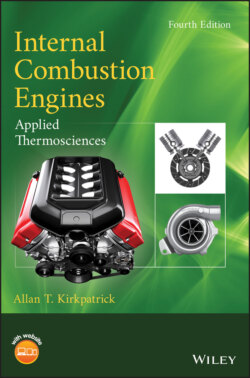Читать книгу Internal Combustion Engines - Allan T. Kirkpatrick - Страница 68
Cylinder Heat and Mass Transfer Loss
ОглавлениеIn this section we develop simple models of the heat transfer and the mass blowby process, and include them in the energy release analysis developed in the previous section. Engines are air or water cooled to keep the engine block temperatures within safe operating limits, so there is a significant amount of heat transfer from the combustion gas to the surrounding cylinder walls. Also, internal combustion engines do not operate on closed thermodynamic cycles, rather there is an induction of fresh charge and expulsion of combustion products, and there is leakage of combustion gases or blowby past the rings, since the rings do not provide a complete seal of the combustion chamber. The blowby can affect the indicated performance, the friction and wear, and the hydrocarbon emissions of the engine.
The heat transfer to the cylinder walls is represented by a Newtonian‐type convection equation with a constant heat transfer coefficient h. More realistic models accounting for a variable h are presented in Chapter 11. The mass flow is assumed to be blowby past the rings from the combustion chamber at a rate is proportional to the mass of the cylinder contents. A useful rule of thumb is that new engines will have a 0.5% blowby, then operate for most of their life at a typical level of 1% blowby, and gradually reach a maximum blowby of 2.5–3.0% at the end of their useful life.
The heat transfer to the walls can be included by expanding the energy release term in the energy equation to include both heat addition and loss, as indicated in Equation (2.91):
(2.91)
The heat loss is
(2.92)
where
The combustion chamber area is a function of crank angle , and is the sum of the combustion chamber area at top dead center , and the instantaneous cylinder wall area. The term includes both the cylinder head, sides, and piston top areas. The instantaneous combustion chamber area and volume are
or
(2.93)
where is the cylinder clearance volume at top dead center. When the parameters in the heat loss equation are normalized by the conditions at state 1, bottom dead center, they take the form
(2.94)
and
(2.95)
The dimensionless heat loss is then
(2.96)
We can express the volume term as a function of the compression ratio . Since ,
(2.97)
For a square engine (bore = stroke ) with a flat top piston and cylinder head geometry,
(2.98)
and
(2.99)
Note that when heat transfer losses are included in the analysis, there are additional dependencies on the dimensionless wall temperature, heat transfer coefficient, and compression ratio.
If the mass in the cylinder is no longer constant due to blowby, the logarithmic derivative of the equation of state becomes
(2.100)
Similarly, the first law of thermodynamics in differential form applicable to an open system must be used.
(2.101)
The term is the instantaneous rate of leakage or blowby flow. The enthalpy of the blowby is assumed to be the same as that of the cylinder, so .
From the mass conservation equation applied to the cylinder
(2.102)
Eliminating between Equations (2.100) and (2.101) yields the following:
(2.103)
Including heat transfer loss as per Equation (2.91), defining the blowby coefficient as
(2.104)
and the dimensionless cylinder mass as
(2.105)
results in the following four ordinary differential equations for pressure, work, heat loss, and cylinder mass as a function of crank angle.
(2.106)
The above four linear equations are solved numerically in the Matlab® program FiniteHeatMassLoss.m, which is listed in the Appendix. The program is a finite energy release program that can be used to compute the performance of an engine and includes both heat and mass transfer. The engine performance is computed by numerically integrating Equations (2.106) for the pressure, work, heat loss, and cylinder gas mass as a function of crank angle. The integration starts at bottom dead center = −180), with initial inlet conditions given. The integration proceeds degree by degree to top dead center and back to bottom dead center. Once the pressure and other terms are computed as a function of crank angle, the overall cycle parameters of net work, thermal efficiency, and imep are also computed. The use of the program is detailed in the following example.
